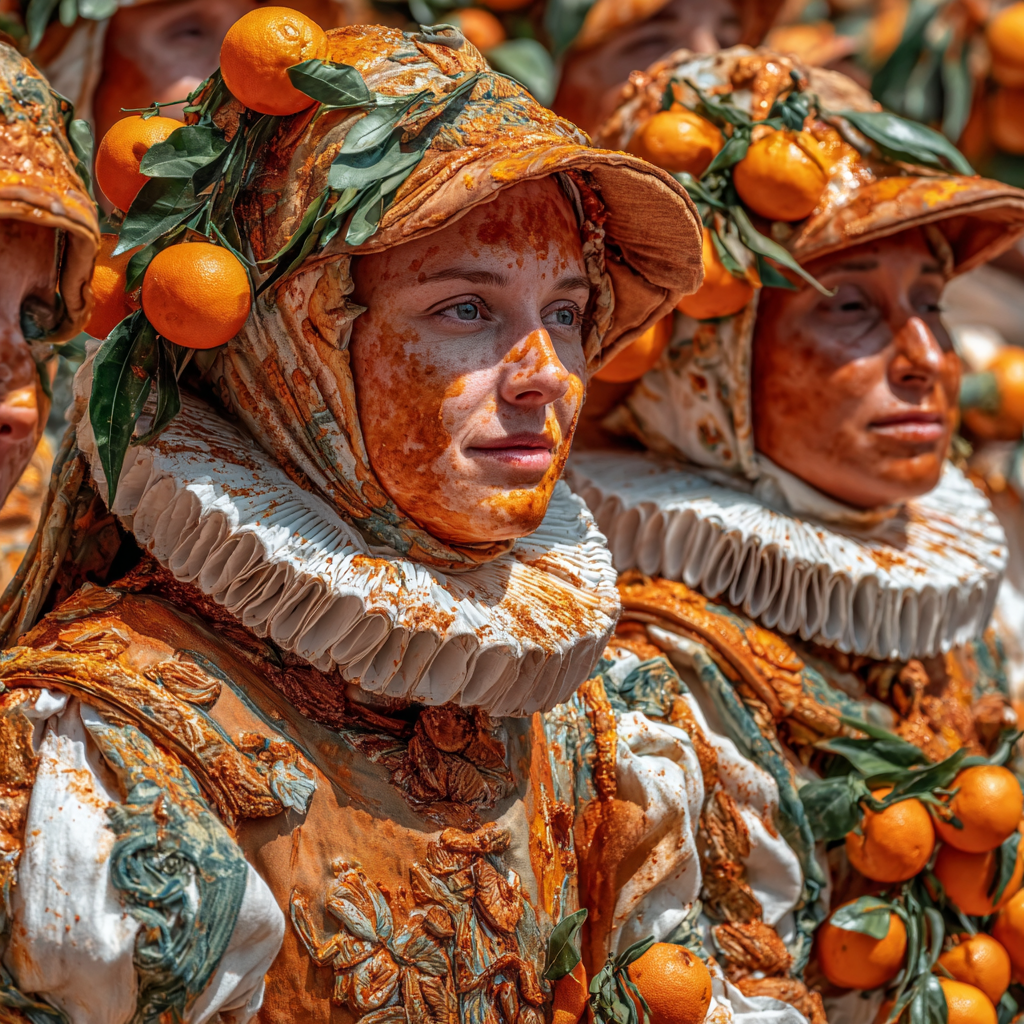Your number one place to find free festivals and events
Battle of the Oranges in Ivrea: A Thrilling Orange War
Imagine a medieval town decorated with colourful flags, where the streets are filled with the sweet aroma of oranges and the shouts of enthusiastic crowds. Welcome to the Battle of the Oranges in Ivrea, Italy, Europe's largest and wildest food fight! This spectacle, part of the historic Carnevale di Ivrea, takes place every year in the days leading up to Ash Wednesday, in 2026 from 15 to 17 February. Thousands of people, divided into nine teams, throw tons of oranges at each other in a vibrant commemoration of a medieval uprising. With parades, music and a healthy dose of chaos, this festival is a unique blend of history, passion and fun. Let's dive into this citrus war with a few juicy stories and tips on how to experience it.


A Rebellious History with an Orange Twist
The Battle of the Oranges is rooted in a legend from the 12th century. According to the story, a tyrannical marquis, often identified as Ranieri di Biandrate, attempted to exercise his droit du seigneur (the right to spend the wedding night with brides) on Violetta, the daughter of a miller. Instead of giving in, Violetta chopped off his head, sparking a popular uprising. The citizens of Ivrea stormed the castle and threw off the yoke of tyranny. This rebellion is now re-enacted with oranges as symbolic weapons: the aranceri (orange throwers) on foot represent the people, while those on horse-drawn carts play the marquis' oppressive soldiers.
Originally, beans were thrown as a sign of contempt for the rulers' meagre gifts, but in the 19th century, oranges, an exotic import from Sicily and Calabria, became the ammunition of choice. By 1947, the modern Battle of the Oranges became official with the creation of the first team, Asso di Picche. Today, nine teams – such as Aranceri della Morte (black with white skull) and Pantera Nera (black with yellow panther) – throw around 600 tonnes of oranges, which equates to more than 4.2 million fruits.
The highlights of the festival
The Orange War: Citrus Chaos The highlight of the festival is the three-day battle, from Sunday to Shrove Tuesday (the Tuesday before Ash Wednesday), which begins daily at 2:30 p.m. Nine teams of aranceri on foot defend their squares, such as Piazza di Città and Piazza Ottinetti, against some 50 horse-drawn carts carrying ‘soldiers’ in medieval armour. Oranges fly through the air with force – sometimes so hard that bruises and black eyes are inevitable! A visitor on Reddit described how he joined Asso di Picche in 2013 and was still grinning with delight after two hits to the head. Although there has been only one fatality since 2013 (due to a heart attack), around 500 people report minor injuries each year. Nevertheless, camaraderie prevails: after each battle, rivals embrace and applaud each other's courage.
The Mugnaia and the Parades Every year, a young woman is chosen as the Mugnaia (miller's daughter), who represents Violetta. Dressed in a white and red dress, she throws flowers and sweets to the crowd from a float. The parades, featuring Napoleon-like generals, Pifferi e Tamburi (bagpipers and drummers) and the Abbà – ten children in Renaissance costumes with oranges on swords – bring the city to life. A funny moment from 2023: the Mugnaia accidentally threw a handful of sweets straight into the face of a spectator, who bowed with a smile! The parades, with flags and historical figures, exude medieval glory and make the festival suitable for all ages.
Fagiolata: Beans for the Warriors Before the battle begins, participants are fed fagiolata, a traditional stew of beans and pork, served with warm vin brulé (spiced wine). This custom recalls the beans that were once thrown in protest against the tyrant's meagre gifts. One visitor wrote on Tripadvisor: ‘The fagiolata was so hearty that I was ready to throw oranges myself!’ This meal, often distributed free of charge, gives the aranceri energy for the battle and adds a tasty tradition to the festival.
The Red Cap: Your Shield Against Oranges Want to watch without getting hit? Wear a berretto frigio, a red Phrygian cap that marks you as a spectator and ‘revolutionary.’ This cap, a symbol of freedom since Roman times, protects you (mostly) from stray oranges. A blogger on My Pretty Travels recounted how she forgot to put on her cap and got hit in the shoulder by an orange – painful, but she laughed it off! Spectators can watch safely from behind nets around the squares or from balconies, which are often rented out for a premium view.


Why Battle of the Oranges is a Must-Visit
The Battle of the Oranges is not just a food fight; it is a living commemoration of freedom and community spirit. The streets of Ivrea, a UNESCO World Heritage Site thanks to the Olivetti factory, become a battlefield of fun, where the scent of citrus fills the air and the cobblestones glisten with orange pulp. Despite the apparent waste, the 600 tonnes of oranges – unsuitable for consumption – are composted or used for energy afterwards, giving the festival a sustainable twist.
The festival is more than just throwing oranges. Enjoy fireworks over the Dora Baltea River, sample local delicacies such as bugie (fried dough sticks with chocolate), and dance along with the Pifferi e Tamburi. For families, there are child-friendly activities, such as performances and the Mugnaia parade. And for daredevils? Sign up with a team (for around £100) and join in the throwing – but wear sturdy clothing! The atmosphere is electric, with teams decorating their squares and supporters singing and cheering. As one photographer, Alessio Ferreri, said: ‘The adrenaline of the Battle of the Oranges makes everything else boring.’
A Citrus Festival to Remember
The Battle of the Oranges is a whirlwind of passion, history and pure chaos, where Ivrea's streets turn orange and the spirit of rebellion comes alive. Whether you're throwing oranges with the Aranceri della Morte, dancing to the sounds of carnival songs, or enjoying a plate of polenta and cod on Ash Wednesday, this festival will set your heart racing. As one visitor wrote on Tripadvisor, ‘You have to see it to understand how Ivrea goes wild once a year!’ So, put on your red cap, taste the fagiolata, and dive into Ivrea's citrus war from 15 to 17 February 2026. Viva la rivoluzione
Practical Tips for a Top Experience
Book Early: Ivrea's hotels are often fully booked six months in advance. Consider staying in Turin (50 kilometres away) and travelling by train (40 minutes).
Wear the Red Cap: Buy a berretto frigio upon arrival in Ivrea to be marked as a spectator. They are sold everywhere, often with pins featuring team logos.
Choose Your Spot: The best viewing spots are Piazza di Città, Piazza Ottinetti or the Ponte Vecchio. For a safe experience, stay behind the nets.
Taste the Flavours: Try fagiolata, bugie and vin brulé in local bars along Via Palestro or by the river. Avoid the cathedral district for food – there is less choice there.
Wear Sturdy Clothing: The streets become slippery with orange pulp. Comfortable, waterproof shoes are a must, and don't forget a raincoat – it can get muddy!
Check the Programme: The festival begins on 6 January with the opening parade, but the battle takes place from 15 to 17 February 2026. Visit www.storicocarnevaleivrea.it for details.

